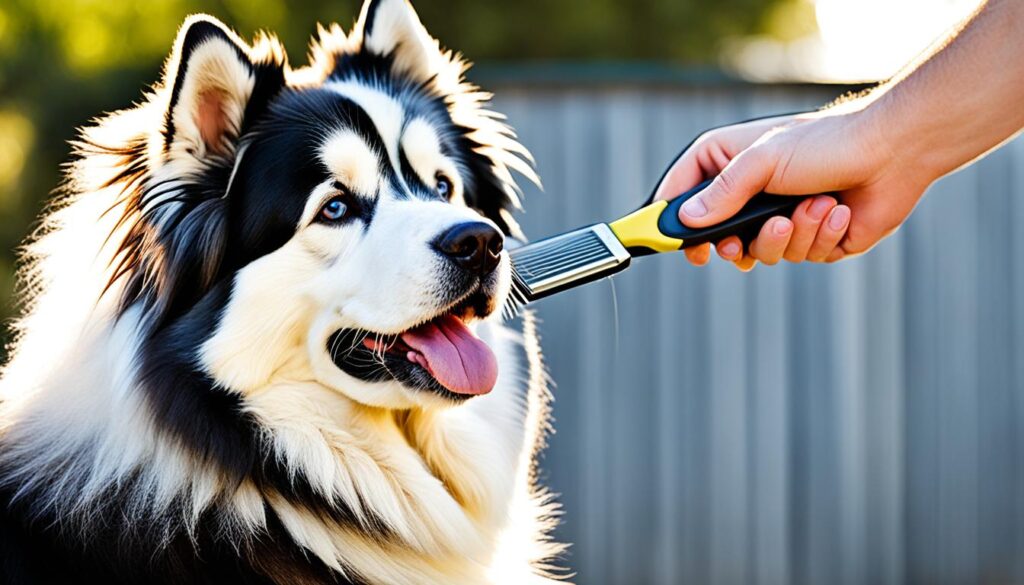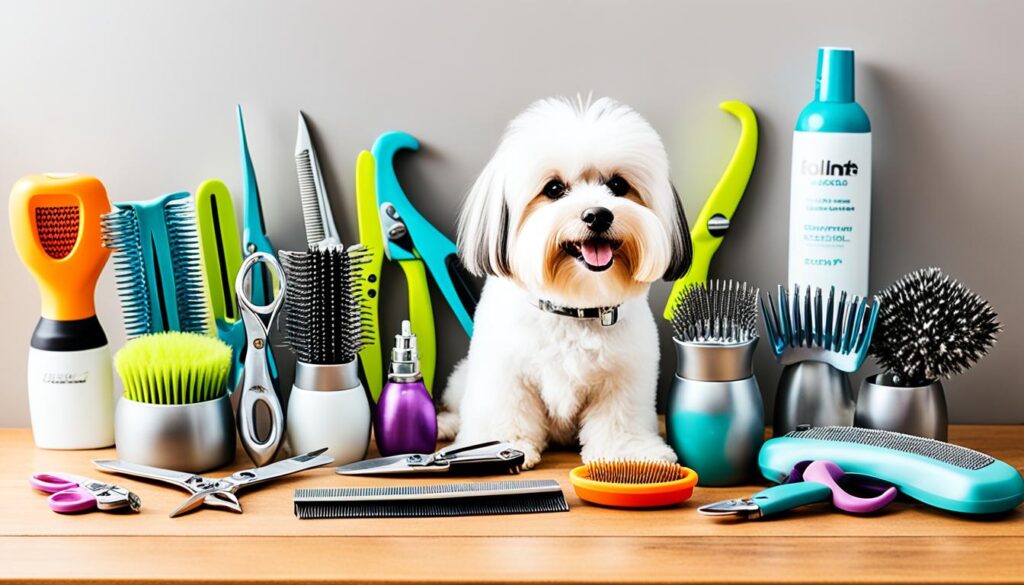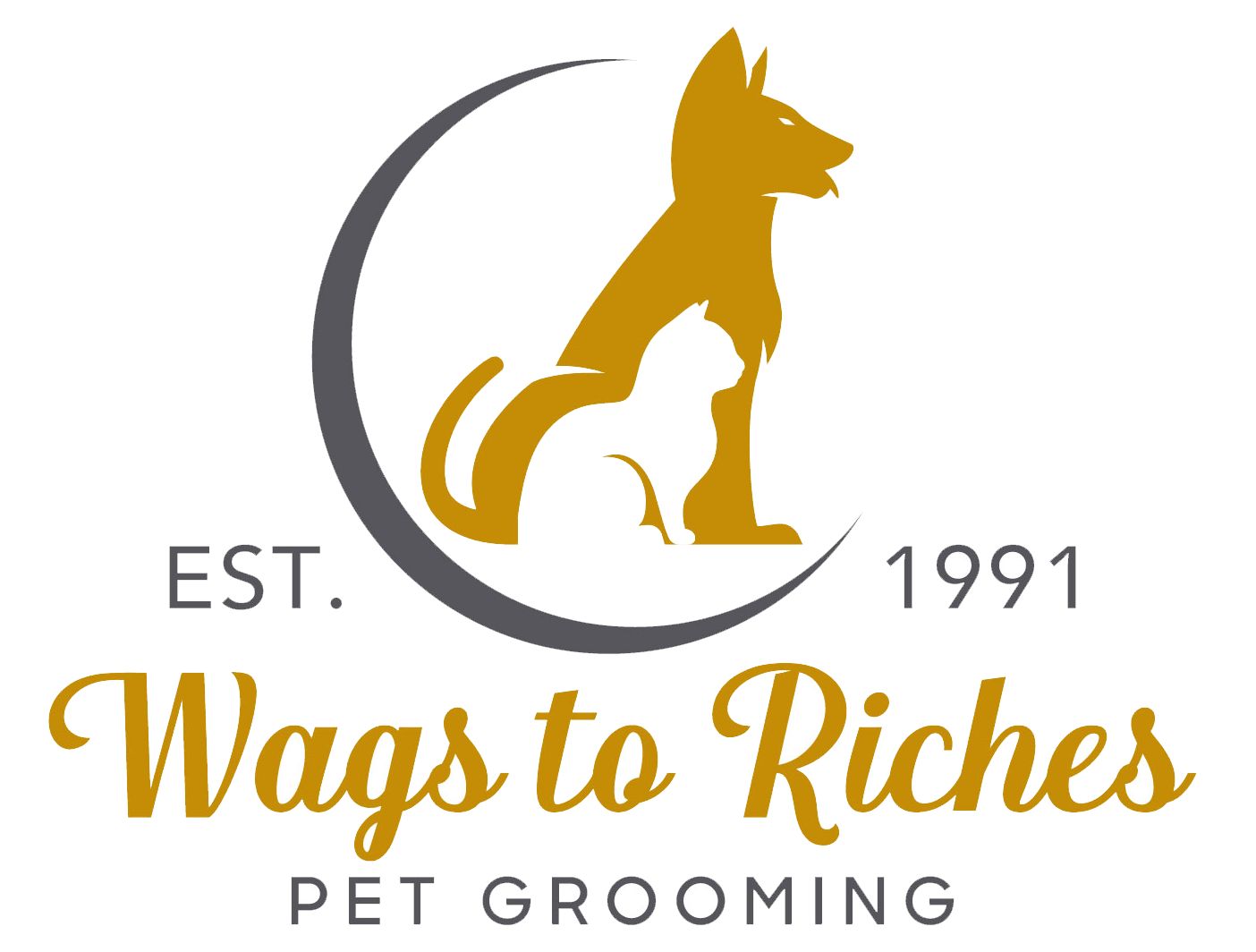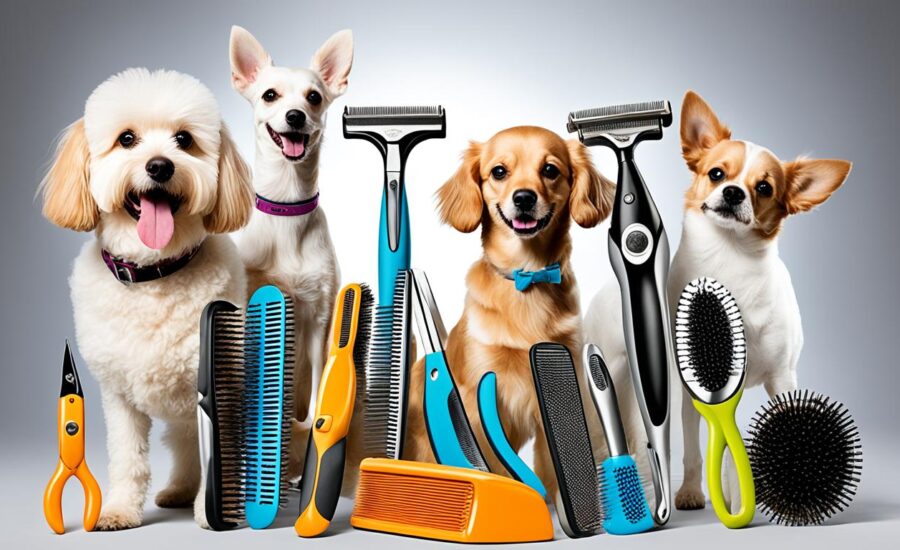Dogs are more than just playful pets. Their coats speak volumes about their well-being. The key to a happy and healthy dog might just lie in grooming. It’s not only about looks but ensuring comfort and health through proper care. Let’s dive into the importance of grooming, where each brush stroke counts a lot.
Key Takeaways
- Identify the unique grooming requirements dictated by various dog coat types.
- Discover why regular grooming is pivotal for both fur-bearing and hair-bearing breeds.
- Learn how a tailored grooming routine aligns with your lifestyle and your dog’s well-being.
- Understand the importance of professional pet care products and the role of a qualified groomer.
- Explore how grooming could be more about health maintenance than aesthetics for your dog.
The Importance of Grooming Across Various Dog Breeds
Breed-specific grooming is crucial for a dog’s well-being. Different breeds have their own grooming needs. These routines are not just for looks but also key for health.
The Role of Grooming in Canine Health and Well-Being
Grooming keeps pets looking great and healthy. It helps catch health issues early. This can stop serious problems.
Regular grooming prevents matting. It keeps dogs comfortable and happy.
How Coat Type Influences Grooming Routines
A dog’s coat type changes the grooming needed. Single-coated breeds need less care than double or triple-coated ones. These need more brushing to manage their undercoat.
| Breed Type | Coat Features | Grooming Frequency |
|---|---|---|
| Single-Coated | Smooth, short hairs | Weekly brushing |
| Double-Coated | Thick with undercoat | Daily brushing during shedding season |
| Triple-Coated | Very dense, outer coat protects against elements | Multiple grooming sessions per week |
Benefits of Regular Grooming: From Looks to Health
Regular grooming keeps your dog looking cute and healthy. It spreads natural oils on their skin and coat. Grooming also strengthens the bond between you and your pet, boosting their emotional health.
Understanding Different Dog Breeds’ Grooming Needs
Each dog breed has its own grooming requirements for a healthy coat. Different breeds need different grooming practices because of their coat types. It’s important to know and follow the right grooming schedules.
Short-haired breeds like Boxers and Beagles do well with less grooming. Just a weekly brushing to lessen hair loss and an occasional bath will do. Medium-haired breeds, such as Cocker Spaniels, need brushing twice a week and regular baths every month to avoid knots and keep their fur clean.

Long-haired dogs, like Shih Tzus, need daily brushing to stay tangle-free and shiny. They also need haircuts every few months. Terriers and Poodles have either wire-haired or curly coats that require special grooming tools and more frequent care to prevent matting and keep their unique look.
- Short-haired breeds: Weekly brushing, occasional baths.
- Medium-haired breeds: Brushing twice per week, monthly baths.
- Long-haired breeds: Daily brushing, regular haircuts.
- Wire-haired breeds: Use of specialized tools, more frequent grooming to prevent matting.
- Curly-haired breeds: Combing to prevent tangles, consistent grooming sessions.
Knowing your dog’s breed-specific grooming requirements helps keep them healthy and happy. Regular grooming is good for their health and strengthens your bond. By following the grooming schedules, your pet will always look and feel loved.
Grooming Essentials for Fur-Bearing and Hair-Bearing Breeds
To keep our dogs healthy and happy, we must know their grooming needs. This is key whether your dog has a lot of fur or a little hair. It’s vital to have a grooming routine that works well for their coat type.
Grooming Challenges and Solutions for Fur-Bearing Dogs
Fur-bearing dogs, like Retrievers and Huskies, shed all year. They have times when they shed even more. Owners should use special grooming tools weekly to help. This keeps shedding under control and the coat looking good. Tools like rakes and de-shedding tools reach the undercoat, pulling out loose fur and stopping tangles.
Special Considerations for Maintaining Hair-Bearing Dog Coats
Hair-bearing dogs, such as Cockapoos and Spaniels, need regular haircuts to prevent their coats from getting too long and tangled. Their grooming involves not just brushing but also deciding on haircuts. Owners can choose trims that are easy to manage or follow the breed’s standard look. This way, dogs stay comfortable and their coats stay healthy.
Let’s look at what fur-bearing and hair-bearing dogs need for grooming. We’ll see how different tools and techniques play a big part in keeping their coats in good shape:
| Breed Type | Grooming Tool | Frequency | Purpose |
|---|---|---|---|
| Fur-Bearing | Rakes, De-shedders | Weekly | Control shedding, maintain undercoat |
| Hair-Bearing | Brushes, Scissors | As needed | Prevent mats, style coat |
Understanding different grooming needs helps dog owners take better care of their pets. Choosing the right tools and knowing how often to groom are key. These steps help keep your dog’s coat healthy and make sure they’re always feeling good.
Practical Tools and Techniques for Efficient Dog Grooming
Grooming your canine friend is not just about looks. It’s a key part of keeping them healthy. Picking the right tools and setting a grooming routine are crucial. This ensures their coat stays in great shape. We’ll dive into how to create the best grooming plan for your dog.
Choosing the Right Brushes and Combs for Your Dog’s Coat
Finding the right grooming tools is the first step. The best brush or comb can really help manage your dog’s fur. For instance, a slicker brush works well for almost all fur types. A fine-tooth comb is perfect for the final touches.
- Slicker Brushes: Ideal for medium to long-haired dogs to remove mats and loose hair.
- Combs: Helps to fine-tune the grooming process and is perfect for areas around the ears and paws.
- Rakes: Designed to penetrate thick coats and remove tangles and undercoat.
Bathing Schedules and the Role of Professional Groomers
It’s vital to figure out how often to bathe your dog. This keeps their coat clean but doesn’t dry it out. Short-haired dogs need fewer baths, but long-haired or active dogs might need more.
Professional groomers play a big role for busy dog owners. They can keep your dog on a routine. Plus, they offer extra grooming services to help you at home.
Haircut Styles: Functionality vs Aesthetics
When choosing your dog’s haircut, think about their needs and your style. You can go for easy-to-care cuts or breed-specific styles. These can really show off your dog’s natural features.
| Breed | Functionality | Aesthetics | Recommended Grooming Frequency |
|---|---|---|---|
| Labrador Retriever | Minimal Trim | Natural Look | 6-8 Weeks |
| Poodle | Simple Sports Cut | Show-Style Cuts | 2-6 Weeks |
| Shih Tzu | Puppy Cut | Top Knot and Show Cut | 4-8 Weeks |
Sticking to these grooming schedules stops matting. It keeps your dog looking and feeling great.

Conclusion
Pet care centers on knowing what our pets need, especially in grooming. Recognizing the grooming requirements of different dog breeds leads to better health and looks. Grooming is more than making them look good. It’s key for avoiding health problems and keeping them well.
By grooming regularly, we can prevent health issues and keep their coats shiny. Grooming plays a big role in pet care. It helps our pets be their best selves. A good groomer offers advice that matches our dog’s needs exactly.
To wrap up, getting the grooming right for different dogs is a big part of being a good pet owner. Grooming strengthens the bond with our pets. It shows our love and keeps them healthy and happy. Good grooming is key to our pets’ well-being and the happiness they give us every day.
FAQ
What are the core differences in grooming needs between fur-bearing and hair-bearing dog breeds?
How does regular grooming contribute to a dog’s health?
Are there specific grooming tools recommended for different coat types?
What are grooming schedules like for various dog breeds?
Can I groom my dog at home, or do I need a professional groomer?
How can I choose the right haircut style for my dog?
What are some breed-specific grooming considerations I should be aware of?
Do all dogs need to be bathed, and how often should I bathe my dog?
How do I deal with shedding for dog breeds with thick undercoats?
What are some common signs that my dog needs grooming?
Source Links
- https://www.julieharrisgroomer.com/blogs/dog-ownership/understanding-breeds-grooming-needs
- https://bestfriendspetcare.com/grooming-for-specific-breeds-or-coat-types/
- https://smoochie-pooch.com/highest-lowest-maintenance-breeds-grooming/

